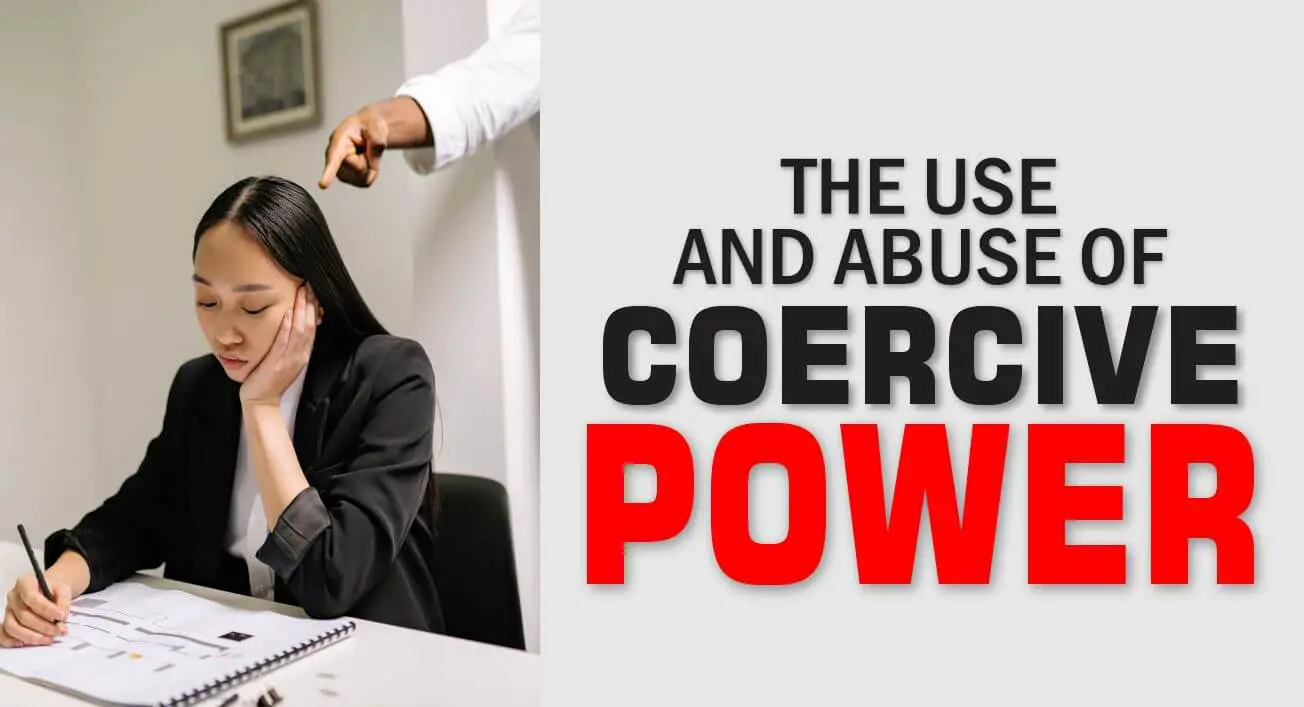Last updated on August 14th, 2023 at 08:04 pm
We see coercive power play out every other time with people being forced to act against their will with consequences attached if they don’t comply.
Several studies have demonstrated that exerting coercive power over staff may initially appear efficient, but it can ultimately impede progress.
Moreover, the company itself, or whoever for that matter, might be at risk of losing valuable employees because of a toxic work environment occasioned by manipulative superiors.
Unlike other types of powers, coercive power employs some outright or minimal intimidation, including mental coercion to get people to comply with a directive.
People exercise the power of coercion in various situations, such as managers who have the authority to fire or discipline employees.
However, sometimes the table can turn, and the power dynamics between individuals shifts.
For example, an employee who has valuable skills or knowledge may have the power of expertise over their employer if they threaten to leave the company.
Understanding the power of coercion and its dynamics is essential in many areas of daily life, from interpersonal relationships to politics and business.
Whichever way, coercion is not a good tool for humans even though it can produce some desired results.
Coercive Power Definition
Coercive power is a type of power that is based on fear and the ability to punish or retaliate, rather than positive incentives or rewards.
In essence, it is the ability to force someone to do something they may not want to do through threats, intimidation, or manipulation.
It makes others do something against their will, generally through physical or psychological pressure.
The power of coercion relies on the fear of loss or harm to force others to comply with the influencer’s wishes.
Leaders who rely primarily on being coercive with their power can create a culture of fear and undermine trust and respect.
In contrast, leaders who use more positive forms of power, such as the power of reference or expert power, can inspire their followers to work together towards common goals.
Where is Coercive Power Used?
This type of power is often used in organizations where top-level executives or managers use threats of demotion, termination, or other disciplinary actions to compel employees to meet performance expectations.
It can be used for both positive and negative purposes.
It can be an effective way to control employees’ behaviours and enforce rules and regulations.
Relate: The Ethics Of Social Power: Using Your Influence Responsibly
It can also be used negatively in cases such as domestic violence, political oppression, or workplace bullying.
But it can also lead to resentment, resistance, and disengagement if used excessively or unjustly.
In politics, nations may use their military power to intimidate and coerce other nations to comply with their desires.
This often results in military conflicts.
Generally, the power of coercion can be an effective tool when used judiciously and fairly, but it can also lead to negative outcomes if not managed properly.

Types of Coercive Power
The power of coercion can come in many forms according to the situation they are applied.
Here are the five types:
1. Physical Coercion
This involves the use of physical force to compel compliance. This can include physical violence or the threat of physical harm. While physical coercion is illegal in most countries, it is still prevalent in some workplaces and can have severe consequences for both employees and employers.
2. Verbal Coercion
Verbal coercion is the use of language to intimidate or threaten someone into compliance. This can include yelling, belittling, or using derogatory language. Verbal coercion can be particularly damaging as it can lead to low morale and a toxic work environment.
3. Psychological Coercion
Psychological coercion involves manipulating someone’s thoughts or emotions to compel them to comply.
This can include gaslighting, emotional blackmail, or manipulation of information. Psychological coercion can be challenging to detect, but its impact on individuals can be long-lasting and severe.
4. Economic Coercion
Economic coercion involves using financial incentives or disincentives to force compliance. This can include withholding wages, reducing bonuses, or threatening to terminate employment.
Economic coercion can be particularly effective in situations where employees are financially vulnerable, but it can lead to resentment and a lack of trust between employees and employers.
5. Legal Coercion
Legal coercion involves using the threat of legal action to force compliance. This can include lawsuits, threats of litigation, or other legal action. While legal coercion can be an effective tool in some situations, it can also be costly and time-consuming.
Characteristics of Coercive Power
While the power of intimidation may seem like a negative trait, it is a reality of the world we live in.
Here are some characteristics that define the power of coercion:
1. Fear and Intimidation
One of the primary characteristics of coercive power is fear and intimidation.
The person or group with this power uses threats of punishment, such as firing or demotion, to keep others in line.
A parent can threaten to renege on their promise of a gift to keep their child obedient.
In the case of the workplace, this can create a culture of fear and intimidation, which can lead to low morale and high turnover rates.
In extreme cases, relying on coercion can lead to bullying and harassment in the workplace.
Related: Power and Control in Relationships
2. Lack of Trust
Another characteristic is a lack of trust. When someone is being coercive in their power approach, others may feel that they cannot trust them.
This can lead to a breakdown in communication and collaboration, as people may be hesitant to share their ideas or opinions for fear of retribution.
3. Resistance and Rebellion
People who are subjected to intimidation may become resentful and rebellious, leading to increased conflict and instability.
In some cases, people may actively resist or sabotage the person or group wielding the power. This can create a vicious cycle of punishment and resistance, which can be difficult to break.
4. Short-Term Effectiveness
While the power of intimidation can be effective in the short term, it often has negative long-term consequences. People may comply with the demands of the person or group with the power of coercion out of fear, but this compliance may be superficial and short-lived.
In addition, the use of the power of coercion can damage relationships and erode trust, making it more difficult to achieve long-term goals.
Related: Personal Power: How To Unleash Your Inner Strength
5. Limited Scope
The power of coercion is often limited in scope, as it can only be used to enforce compliance with specific demands. It does not necessarily lead to genuine commitment or engagement from others.
In addition, wielding this power can create a negative reputation for the person or group using it, which can limit their ability to influence others in the future.
6. Unpredictability
Those who wield this power can be unpredictable, making it difficult for others to know what to expect from them. This unpredictability can create anxiety and stress for those affected by this type of power.
7. Harsh Consequences
Being coercive in the use of power often involves harsh consequences for those who do not comply with the demands being made. It could mean losing a job, receiving punishment, or even facing physical harm.

Impacts of Coercive Power on Employee Work Life
Coercive power can have a significant impact on the work life of employees, leading to demotivation, lack of job satisfaction, and overall loss of well-being.
Here are the impacts on employee work life:
1. Decreased Motivation
When employees are coerced into compliance, they are less likely to be motivated to complete tasks.
They may feel like they are being forced to do something rather than being able to take ownership of their work.
This can lead to a lack of creativity and innovation, which can ultimately harm the organization’s performance.
Related: Fear Propaganda: How It is Used For Psychological Manipulations
2. Reduced Job Satisfaction
It can lead to decreased job satisfaction among employees. They may feel like they have no control over their work and are not valued by the organization.
This can lead to feelings of disengagement, frustration, and even resentment towards their employer.
3. High Turnover Rates
When employees are subjected to coercive power, they may become disengaged and start looking for new job opportunities.
This can lead to high turnover rates, which can be costly for the organization in terms of recruitment and training.
4. Poor Mental Health
It can have a significant impact on the mental well-being of employees. It can lead to increased stress, anxiety, and depression, which can ultimately harm their overall well-being.
This can have a domino effect, leading to decreased productivity, increased absenteeism, and even long-term health problems.
5. Toxic Work Environment
It can create a toxic work environment where employees are afraid to speak up, take risks, or make mistakes.
This can lead to a culture of fear and mistrust, which can ultimately harm the organization’s reputation and bottom line.
Related: Referent Power In Leadership For Effective Followership
Examples of Coercive Power
The power of coercion can be exercised in many places where there are leaders and subordinates, just as it can serve a negative or positive purpose.
A manager who threatens to withhold a promotion or a salary increase unless an employee does something that goes against their values or beliefs is a good example.
Here are other examples:
- A police officer uses the threat of arrest to coerce a suspect into confessing to a crime.
- A supervisor threatens to fire an employee if they do not work overtime, even though the employee has already worked the required hours.
- A government uses the threat of military force to coerce another country into complying with its demands.
- A teacher threatens to give a failing grade to a student if they do not complete an assignment, even though the assignment may not be relevant to the course material.
- A parent takes away a child’s phone or other privileges to coerce them into behaving in a certain way.
- A dictator uses force to suppress political opposition and maintain control over the country.
- A coach threatens to bench a player if they do not follow their instructions, even if the instructions may not be in the player’s best interest.
Sources of Coercive Power
The source can be any of the other types of power.
It is always an offshoot of the other powers including legitimate, reward, expert, referent, and information powers.
- Legitimate Power: Legitimate power can be a source of the power of intimidation when it is applied to arm-twist individuals for any reason. It is always associated with leaders and managers who have the authority to make decisions and enforce rules.
- Reward Power: The power of reward also, can be a source of coercive power. It is a type of power that gives rewards in exchange for performance. For instance, a manager might promise to use promotion to get employees to perform well. It can be a source when it is used coercively or to manipulate others.
- Expert Power: The power of expertise can also be an avenue to exercise the power of coercion. It is the power that is based on an individual’s knowledge or expertise in a particular area. It is associated with professionals and can be wielded to arm-twist employers to do their bidding. An example is when an employee threatens to resign if their desires are not met.
- Referent Power: Also, the referent power can be used to perpetuate coercion. It is the type of power exercised by individuals due to their charisma, beauty, or other personal characteristics. It becomes a source when used to manipulate or force others to do their bidding.
- Information Power: The power of information is the power that is based on an individual’s access to information. This source of power is often associated with individuals who have access to confidential or sensitive information. Information power can be a positive source of power when used to make informed decisions, but it can also be misused when individuals use the information to manipulate or control others.
Effects of Coercive Power
In any setting, the use of force can result in both positive and negative effects on individuals and groups.
What are the Advantages of Coercive Power?
- Clear Expectations: The use of coercion, when balanced with other leadership styles, can set clear expectations for what is expected of subordinates. This can improve communication, reduce misunderstandings, and ensure everyone is on the same page when it comes to reaching organizational goals.
- Immediate Compliance: When time is of the essence or in emergency situations, the power of coercion can be helpful in ensuring quick and immediate compliance to ensure the safety of individuals or groups.
- Protection: The use of manipulative power can protect individuals or groups from harm. For instance, police officers have the authority to use their power of coercion to restrain someone who is threatening or violent.
- Control: Coercion can help maintain order and control within an organization. Leaders who have access to this type of power can temporarily quell the conflict and ensure organizational policies are being followed.
What are the Disadvantages of Coercive Power?
- Fear and Intimidation: The use of coercion can create a culture of fear and intimidation within an organization. Leaders who rely on coercion to get things done often communicate their authority through aggressive or hostile behavior that can leave subordinates feeling scared or intimidated.
- Lack of Motivation: Individuals and groups may become demotivated if they only comply with demands because of fear of the consequences of non-compliance rather than a genuine commitment to the task at hand. This can lead to low morale, apathy, and low productivity.
- Resistance and Retaliation: Coercion often results in resistance to the commands or requests of the person in authority. Some subordinates may choose to retaliate against the coercive leader, either overtly or covertly, which can lead to more conflict within the organization.
- High Turnover: A coercive leader can drive people away, leading to a high turnover rate in the organization.
Examples of organizations that use coercive power effectively:
- Law Enforcement Agencies: Police forces, intelligence agencies, etc. have the legal authority and ability to use force to enforce laws and maintain public safety. The positive effects of their activities are the reduction of crime, protection of citizens’ rights and freedoms, and maintaining social order.
- Military: Armies of various countries also have the ability to use coercion, which allows them to defend their country from internal or external threats. Their positive effects are preserving national sovereignty, preventing aggression, and maintaining peace.
- Employers: In some situations, employers may use the power of coercion to enforce employee compliance with safety and security rules or to maintain productivity. This can create a safe working environment, prevent accidents or mistakes, and increase efficiency.
- Parental Authority: Parents have the authority to use coercion over their children to ensure that they grow up with proper values and behaviors. When used appropriately, this can nurture a respectful and responsible individual.
- Governments: Governments may use the power of force to enforce tax laws, collect fines, and ensure that citizens comply with laws and regulations. This can help fund public services and keep cities and countries running effectively.
Coercive Power in Everyday Life
The power of force is present in everyday life in various forms, and it can be used by individuals, organizations, and even governments.
1. Coercive Power in Personal Life
In personal life, parents often use the power of force or manipulation over their children to make them behave well or to study harder.
They may threaten punishment or take away privileges if the child does not follow the rules.
Similarly, in relationships, one partner may use coercion to control the other, such as threatening to leave or manipulating them emotionally.
2. Coercive Power in the Workplace
In the workplace, bosses or supervisors may use the power of coercion to force employees to work harder or meet certain goals.
This can create a high-pressure work environment that can be stressful and harmful to the mental health of employees.
3. Coercive Power in the Government
Governments often use coercion over their citizens to maintain order and control.
This can be seen in laws and regulations that are enforced through fines or other punishments.
For example, not wearing a seatbelt while driving can result in a ticket and a fine.
It is important to recognize the use of coercive force in everyday life and strive to use other forms of power, such as persuasive or collaborative power.
In relationships and the workplace, communication, and compromise can be more effective in achieving goals than the use of coercive power.
Compare and Contrast Coercive Power and Reward Power
Reward power and the power of coercion are two types of power that leaders can use to influence others.
While both types of power can be effective, they are fundamentally different in their approach and outcomes.
In this comparison, we will explore the similarities and differences between reward power and coercion.
Definition and Approach
Reward power is the ability to offer positive incentives or rewards to influence others.
This can include things like bonuses, promotions, recognition, or other forms of positive feedback.
Leaders who use reward power seek to motivate and inspire their followers by offering them something that they value.
Coercion, on the other hand, is the ability to use threats, punishment, or force to influence others.
This can include things like disciplinary action, demotions, or other forms of negative feedback.
Leaders who use coercive power seek to control and manipulate their followers by instilling fear or intimidation.
Outcome and Effectiveness
Reward power is generally seen as a more positive and effective form of power.
When leaders use reward power, they can motivate their followers to work harder, be more productive, and feel more invested in their work.
By offering positive incentives, leaders can create a sense of loyalty and commitment among their followers.
Coercion, on the other hand, is generally seen as a more negative and less effective form of power.
When leaders use manipulation or coercive force, they can create a climate of fear and mistrust among their followers.
This can lead to low morale, high turnover rates, and a lack of commitment to organizational goals.
While threat and intimidation can be effective in the short-term, it often leads to long-term negative consequences.
Situational Factors
Both reward power and coercion can be effective or ineffective depending on the situation.
For example, reward power may be more effective in situations where individuals are motivated by extrinsic rewards, such as money or recognition.
Coercion may be more effective in situations where individuals are engaged in dangerous or unethical behavior and need to be stopped immediately.
How to Get it Right with the Power of Coercion
So far, we have observed that the use of coercion power can merely yield outcomes in the short term.
How then can corporations encourage their employees to do the right thing without resorting to coercive power or intimidation?
The administration must recognize that there are diverse methods to use power from a position of authority.
Also, power can be exercised to gain influence and effect on employees that will produce enduring benefits for all.
Influence is an effective model of leadership, and it is earned, not compelled.
If the corporation invests in inculcating in its leaders, effective leadership approaches and personnel management competencies, there is likely no requirement to apply coercion in most situations.
However, there are situations where the use of the power of coercion may be necessary to enforce rules and regulations, especially in high-risk industries.
Here are some tips on how to get it right with coercive power:
- Use it Sparingly: Coercion should only be used when necessary and in moderation. Overusing it can lead to negative consequences, including employee disengagement, resentment, and turnover.
- Be Clear and Consistent: Rules and regulations should be clearly communicated to employees, and consequences for non-compliance should be consistent and fair. This helps to create a sense of accountability and transparency, which can minimize the need for the use of coercive power.
- Provide Alternative Options: Whenever possible, provide alternative options for employees to comply with rules and regulations. This can include training, coaching, or mentoring, which can help to build skills and knowledge and reduce the need for coercion.
- Focus on Positive Reinforcement: Positive reinforcement can be a powerful tool for promoting compliance and reinforcing positive behaviours. This can include rewards, recognition, and other incentives that encourage employees to do the right thing.
- Encourage Employee Voice: Encouraging employee voice can help to create a culture of trust and respect, where employees feel comfortable raising concerns and providing feedback. This can help to minimize the need for coercion and promote a more positive workplace culture.
Conclusion
Coercive power is an important aspect of organizational power dynamics that can be used to persuade or compel individuals to take certain actions.
While it can be effective in the short term, the use of the power of threat and intimidation can be damaging to organizational culture and long-term relationships between colleagues.
Leaders and managers need to be aware of the potential negative impact that coercion can have and try to use other forms of power to motivate and inspire their teams.
Additionally, employees also need to be aware of their rights and should speak out if they feel they are being unfairly treated.
It is important for organizations to create a culture of respect and mutual understanding where communication and collaboration are valued over the use of intimidation, punishment, or force.
Ultimately, a balance of power is necessary within organizations to ensure that the use of coercion does not become the dominant force.
Pyo Merez (PsyD) is a distinguished adolescent and adult psychologist at the forefront of mental health advocacy.
With expertise in cognitive and developmental psychology, focusing on social relationships, cultural contexts, and individual differences, Pyo has dedicated his career to empowering adolescents and adults.
As a sought-after speaker and panelist, Pyo shares invaluable insights on issues affecting young people, contributing to a deeper understanding of mental health and well-being in today's society.


